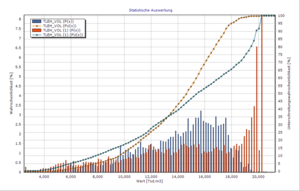Wave:Histogram: Difference between revisions
Jump to navigation
Jump to search
(translate to English) |
(Histogram bins are user-definable since v1.6.1) |
||
| Line 3: | Line 3: | ||
==Description== | ==Description== | ||
[[Bild:Wave Statistik.png|thumb|300px|Screenshot]] | [[Bild:Wave Statistik.png|thumb|300px|Screenshot]] | ||
The analysis function '''Histogram''' divides the entire range of values into a series of intervals (bins) and then counts how many values fall into each interval. The result diagram contains the following: | The analysis function '''Histogram''' divides the entire range of values into a series of user-defined intervals (bins) and then counts how many values fall into each interval. The result diagram contains the following: | ||
* Probability (<code>P(x) = frequency / total amount</code>) | * Probability (<code>P(x) = frequency / total amount</code>) | ||
* Probability of subceedance (<code>PU(x) = cumulative frequency / total amount</code>) | * Probability of subceedance (<code>PU(x) = cumulative frequency / total amount</code>) | ||
| Line 9: | Line 9: | ||
;Remarks | ;Remarks | ||
:You can only analyse multiple series at the same time if they use the same unit | :You can only analyse multiple series at the same time if they use the same unit | ||
[[Category:BlueM.Wave|H]] | [[Category:BlueM.Wave|H]] | ||
Revision as of 06:10, 3 March 2017
Description
The analysis function Histogram divides the entire range of values into a series of user-defined intervals (bins) and then counts how many values fall into each interval. The result diagram contains the following:
- Probability (
P(x) = frequency / total amount) - Probability of subceedance (
PU(x) = cumulative frequency / total amount)
- Remarks
- You can only analyse multiple series at the same time if they use the same unit

